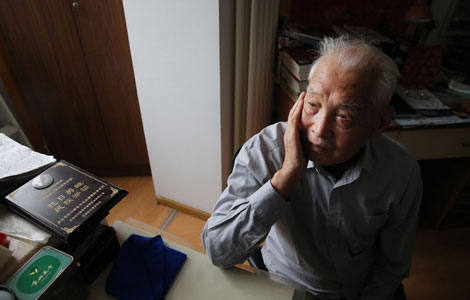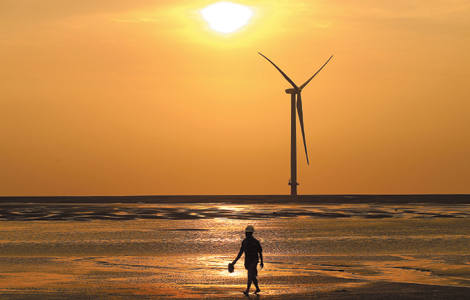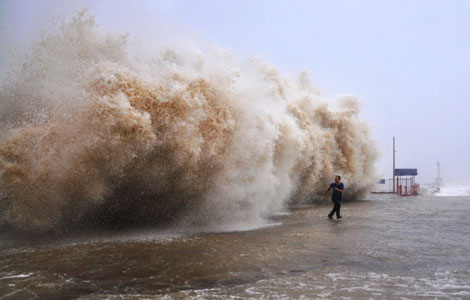Beijing sewage plants lag behind
Updated: 2013-09-24 01:06
By Zheng Xin (China Daily)
|
||||||||
City's rapid population growth has 'far exceeded infrastructure capacity'
Untreated waste is spilling into the capital's rivers, a fact that city authorities openly acknowledge.
The capacity of sewage disposal plants in Beijing is far behind the rapid rate of urban development in the capital, especially around the rural-urban fringe zone.
 |
|
Qinghe River has become foul-smelling as the sewage plants along the riverside are overwhelmed and untreated waste is discharged directly. wang jing / china daily |
In many places, polluted water is directly discharged into rivers without treatment, according to the Beijing Environmental Protection Bureau.
Statistics from the Beijing Water Authority show that only 83 percent of the city's wastewater is treated, with the remaining 17 percent discharged into rivers without treatment.
The population of the city has far exceeded infrastructure capacity, said Han Yongqi, director of the management office of water and ecological environment at the bureau.
The city's water pollution treatment facilities are based on the city's population hitting 18 million by the end of 2020, he said.
However, the pace of growth has been seriously underestimated. The capital's population exceeded 20 million last year, according to the city's statistics bureau.
An investigation into the quality of surface water in the capital, released by the Department of Environmental Protection at the North China Center for Environmental Inspectors in early August, found all its 50 rivers, except nine that had run dry, were polluted.
In addition to ammoniacal nitrogen pollution, which affects some 35 percent of the city's rivers, chemical oxygen demand and phosphorus pollution are common, according to the report.
Treating the surface water pollution is no easier than tackling air pollution in the city, said an insider from the Beijing Water Authority, who spoke on condition of anonymity.
Wastewater treatment plants only cover around 60 percent of some densely populated regions, especially the urban-rural fringe zones, according to the investigation. At some farms, the excrement of animals is discharged into the rivers, it said.
Han said the source of water pollution is mainly domestic wastewater and the discharge problem is especially serious in urban areas.
The Qinghe River, a 23.6-kilometer-long waterway in the northern part of the city, is basically a foul-smelling sewer, with untreated waste discharged directly into it.
The number of residents in the Qinghe area soared from 800,000 to 2.9 million from 2003 to 2011.
The sewage plants located along the riverside are overwhelmed. According to the city's water authority, the government has been enlarging the capacity of sewage treatment plants since 2007, yet is has so far been unable to match the growth in residents.
According to Han, the government's continuing efforts should result in a great improvement in the city's water quality over the next three years.
However, considering the pace of urban development and the present water pollution levels, it may take some time for all the city's rivers to reach an acceptable standard.
First Person | Jian Geming
Tales from the riverbank
Editor’s note: A resident talks to Zheng Xin about living with the smell on the banks of the Qinghe River.
Despite increased options in treating sewage, the river’s water quality has barely improved over the past few years.
During peak water use in the city, untreated sewage is discharged through outlets, many of which are concealed, in a rudimentary fashion, behind rocks.
Usually, raw sewage flows out in the evening, mostly domestic sewage, and residents, especially those living by the riverside on the lower reaches, keep the windows closed.
Sometimes, arriving home on the bus at night, you can close your eyes and gauge how close you are to your stop just by the smell.
The sewage will have gone from the upper reaches to the lower reaches by the next day, so little waste is seen floating in the water. At this time, the smell is not so bad. You can even take a riverbank stroll and almost not smell anything.
However, even during the daytime, the occasional smell from the drains still reminds us of the filth and pollution.
The sad thing, however, is not just the state of the river, but that the residents have been getting used to the odor over the past few years, despite lodging complaints.
Some neighbors have had enough and sold their apartments while others take preventive measures, such as buying air filters and placing as many plants as possible in their living areas.
Considering most of the untreated sewage discharged into the river is domestic waste, I think it would be worthwhile if the government equipped local communities with water-purifying equipment so that they could tackle the sewage themselves.
The government has been making promises to step up sewage treatment yet we barely see the results.
We all know the key problem is the amount of people living by the river yet the government needs to think of the infrastructure problem before setting up communities and selling apartments.
According to Beijing News, the population of the Qinghe River area has reached 2.92 million, far exceeding what the sewage treatment facilities were planned for — 1.94 million.
The good news is that the installation of wastewater treatment facilities will be completed by the end of September.
Yan Ran contributed to this story.
Most Viewed
Editor's Picks

|

|

|

|

|

|
Today's Top News
China announces pricing policy for fuel upgrade
Microsoft to set up Chinese joint venture
China to increase rare earth purchase
Maduro aims to build trade plan with China
Sino-US college venture focuses on public health
Shanghai regulates govt-funded overseas training
Hong Kong kungfu drama to compete for Oscar
China to help deal with chemical weapons
US Weekly

|

|













